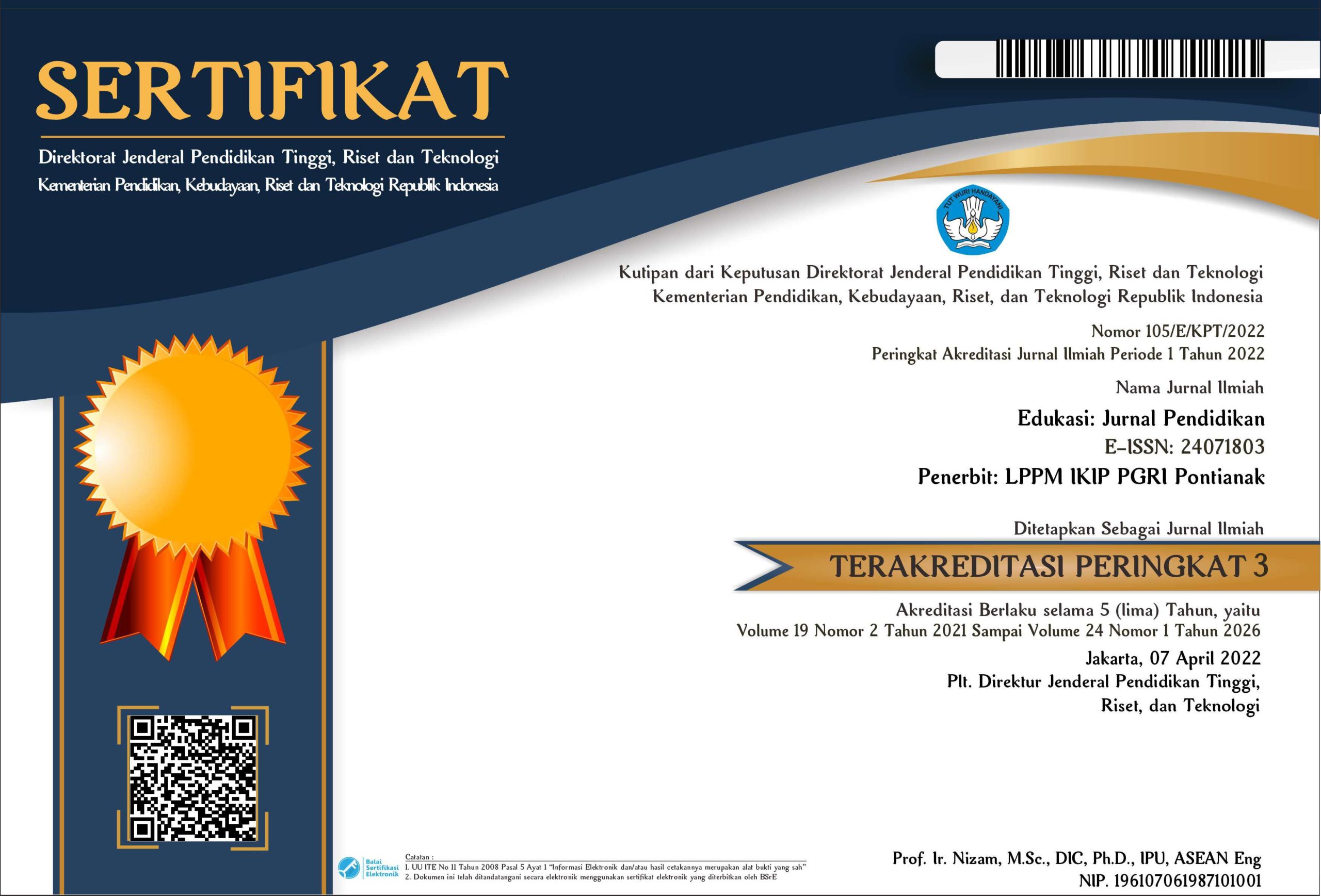ENGLISH TEACHING STRATEGIES TO STUDENTS IN AN INCLUSIVE SCHOOL
DOI:
https://doi.org/10.31571/edukasi.v21i2.6262Keywords:
English teaching strategies, children with special needs, inclusive educationAbstract
This research aimed to investigate the teacher strategies in teaching English to children with special needs in Zonakata Inclusive School, Pontianak, Indonesia. This research was designed as qualitative case-study research. This design was chosen to help the researcher gain deep information about the phenomenon discussed and to explore the case intensively based on the real-life context. The research participants were two teachers in Zonakata Inclusive School who teach English to children with special needs in grade three. To get the data, observation, interview, and document review were used. The data collected was then analysed using thematic analysis. This study showed that the teachers used co-teaching and differentiated teaching strategies with the help of visual media to teach English to children with special needs. In conclusion, the participants' combination of those strategies was proven to be implemented and encouraged to be used to teach English to children with special needs.
Downloads
References
Boland, D. E., Alkhalifa, K. B., & Al-Muhtari, M. A. (2019). Co-teaching in EFL classroom: The promising model. English Language Teaching, 12(12). https://doi.org/DOI: 10.5539/elt.v12n12p95
Braun, V., & Clarke, V. (2006). Braun, V ., Clarke, V .Using thematic analysis in psychology., 3:2 (2006), 77-101. Qualitative Research in Psychology, 3.
Caulfield, J. (2019). How to do thematic analysis. Scribbr. https://www.scribbr.com/methodology/thematic-analysis/
Data Referensi Kementerian Pendidikan & Kebudayaan. (n.d.). Jumlah data satuan pendidikan (sekolah) per kabupaten/kota.
Ford, J. (2013). Educating students with learning disabilities in inclusive classrooms. Electronic Journal for Inclusive Education, 3(1).
Jamaican Association for the Deaf. (2015). Who are the children with special needs? JAD.
Morina, S. (2019). Differentiated teaching strategies with children with learning difficulties. Prizren Social Science Journal, 3(3). https://doi.org/10.32936/pssj.v3i3.122
Nishanti, R. (2018). The importance of learning English in today world. International Journal of Trend in Scientific Research and Development, 3(1). https://doi.org/10.31142/ijtsrd19061
Nuriyanti, I., Yuliawati, F., & Rohaniyah, J. (2021). Teaching English for down syndrome students at SMPLB PGRI in Pamekasan. ELT in Focus, 4(1), 43–52. https://doi.org/10.35706/eltinfc.v4i1.5240
Padmadewi, N. N., & Artini, L. P. (2017). Teaching English to a student with autism spectrum disorder in regular classroom in Indonesia. International Journal of Instruction, 10(3), 159–176. https://doi.org/10.12973/iji.2017.10311a
Pemerintah Kota Pontianak. (2021). Pemkot Pontianak siapkan 36 sekolah inklusi. Pemerintah Kota Pontianak. https://www.pontianakkota.go.id/pontianak-hari-ini/berita/Pemkot-Pontianak-Siapkan-36-Sekolah-Inklusi
Ranjeeta. (2018). Teaching strategies for learners with special educational needs. National Journal of Multidisciplinary Research and Development, 3(1), 696–698.
Rante, S. V. N., Helaluddin, Wijaya, H., Tulak, H., & Umrati. (2020). Far from expectation: A systematic literature review of inclusive education in indonesia. In Universal Journal of Educational Research (Vol. 8, Issue 11). https://doi.org/10.13189/ujer.2020.082273
Schoch, K. (2020). Case study design. In Research design and methods: An applied guide for the scholar-practitioner (pp. 245–258). SAGE Publications. https://uk.sagepub.com/sites/default/files/upm-binaries/105275_ch16_01.pdf
Scruggs, T. E., Mastropieri, M. A., & Marshak, L. (2012). Peer-mediated instruction in inclusive secondary social studies learning: Direct and indirect learning effects. Learning Disabilities Research & Practice, 27, 12–20.
Statista Research Department. (2021). Number of primary schools in Indonesia from 2011 to 2020. Statista.
Stein, D. (2011). Behavior and Down syndrome: A practical guide for parents. Children’s Hospital Boston.
The World Bank. (2021). Realizing schools that unlock the potentials of Indonesian children with disabilities. The World Bank. https://www.worldbank.org/en/news/feature/2021/10/19/realizing-schools-that-unlock-the-potentials-of-indonesian-children-with-disabilities#:~:text=The MoECRT in Indonesia has promoted inclusive education,from 3%2C610 to 28%2C778 between 2015 and 2020.
Tissot, C., & Evans, R. (2003). Visual teaching strategies for children with autism. Early Child Development and Care, 173(4). https://doi.org/10.1080/0300443032000079104
Vaughn, S., Schumm, J. S., & Arguelles, M. E. (1997). The ABCDEs of co-teaching. Teaching Exceptional Children, 30(2). https://doi.org/10.1177/004005999703000201
Wiliyanto, D. A. (2017). Analysis of teachers’ understanding level, needs, and difficulties in identifying children with special needs in inclusve school in Surakarta. Journal of Education and Learning (EduLearn), 11(4). https://doi.org/10.11591/edulearn.v11i4.6387
Zhang, M., Jiao, J., Huang, Y., Hu, X., Yang, P., Situ, M., Huang, Y., Guo, K., & Cai, J. (2020). Exploring the spatial working memory and visual perception in children with autism spectrum disorder and general population with high autism-like traits. PLoS ONE, 15(7). https://doi.org/10.1371/journal.pone.0235545
Downloads
Published
How to Cite
Issue
Section
License
Copyright (c) 2023 Refka Darmayanthi Putri Mahisa, Yanti Sri Rezeki, Surmiyati Surmiyati

This work is licensed under a Creative Commons Attribution-NonCommercial 4.0 International License.
Authors who publish in this journal agree to the following terms:
- Authors retain copyright and grant the journal the right of first publication with the work simultaneously licensed under a Creative Commons Attribution License (CC-BY-NC) that allows others to share the work with an acknowledgment of the work's authorship and initial publication in this journal.
- Authors are able to enter into separate, additional contractual arrangements for the non-exclusive distribution of the journal's published version of the work (e.g., post it to an institutional repository or publish it in a book), with an acknowledgment of its initial publication in this journal.
- Authors are permitted and encouraged to post their work online (e.g., in institutional repositories or on their website) prior to and during the submission process, as it can lead to productive exchanges, as well as earlier and greater citation of published work.

 Download: 291
Download: 291


















